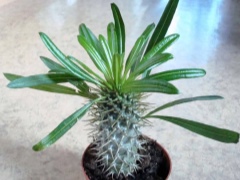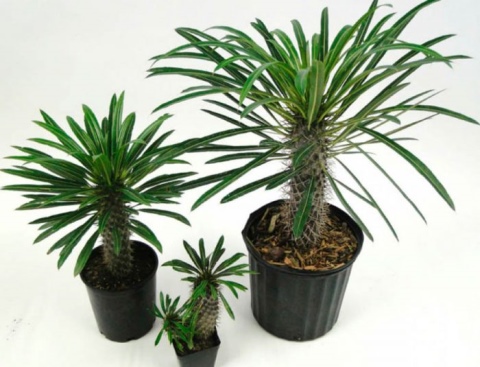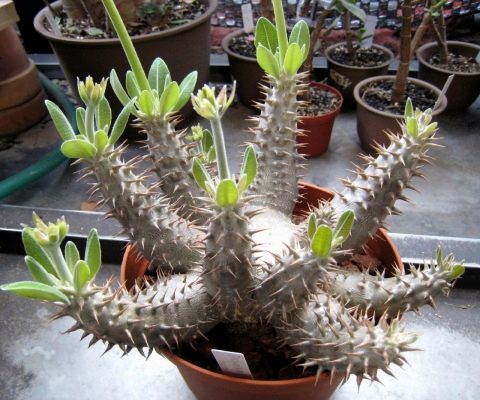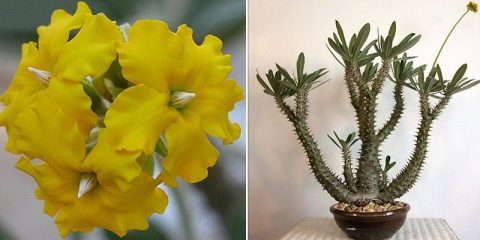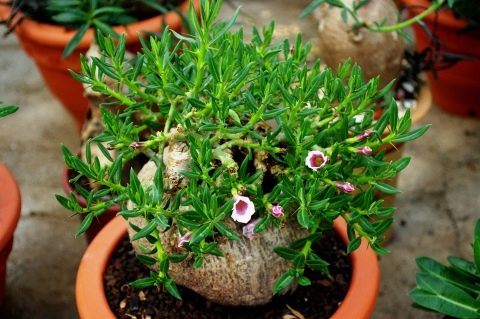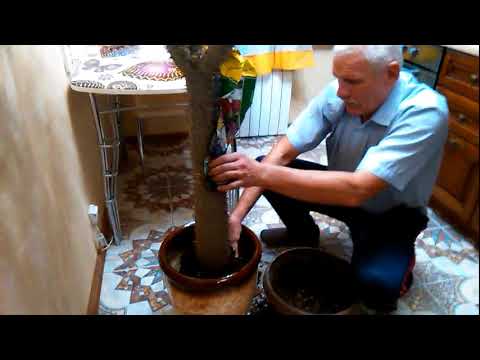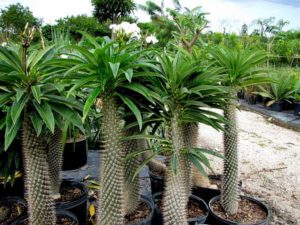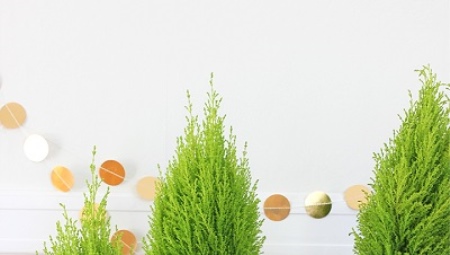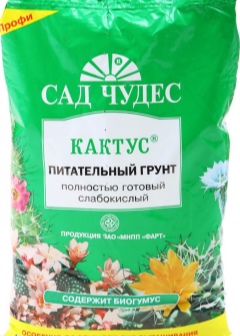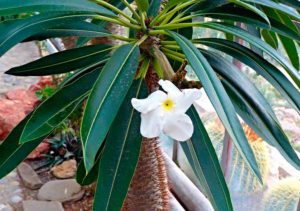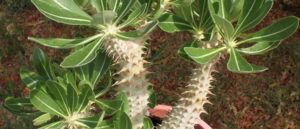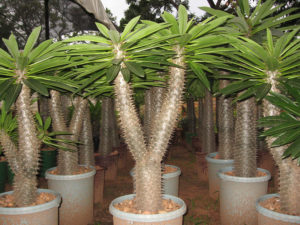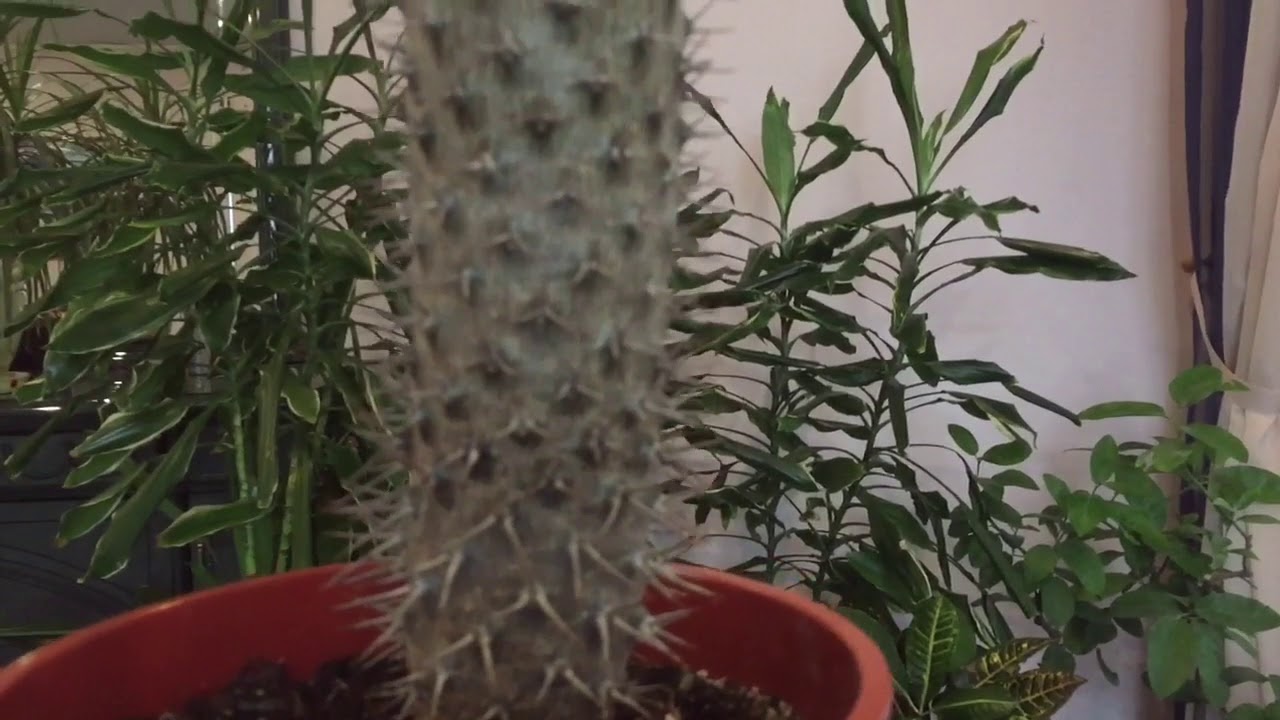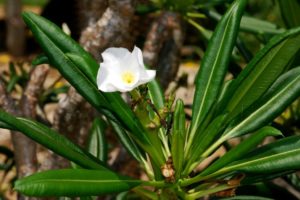Characteristics
The pachypodium is native to the arid regions of Africa, Madagascar and Australia. It belongs to the succulents of the Kut family. Due to its original appearance, it cannot be confused with any other plant. It looks like a palm tree and a cactus at the same time. The thick stem, or rather the trunk, bristles with sharp thorns, and the long narrow leaves are gathered closer to the crown in the form of a tuft.
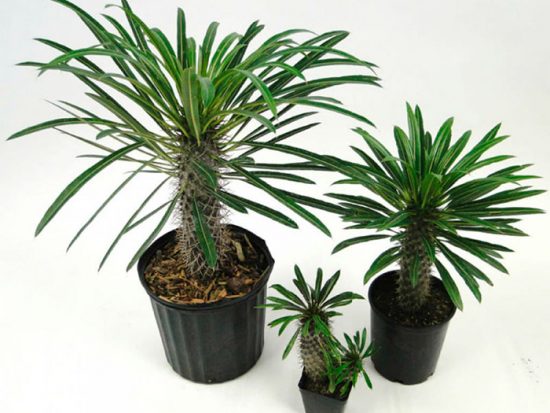
In nature, it grows as a real tree up to 8 m high, but at home it is much more compact - no higher than 1.5 m, its usual height is 70 cm.The main purpose of a thick fleshy stem is to create a supply of moisture, so it is not afraid of the sun and drought. He can live with the owner for up to 15 years if he creates acceptable conditions for him. The pachypodium blooms only for 6 years with beautiful white-cream buds, which, in addition, also smell nice.
More than 20 species of pachypodium have been studied in nature, we will list the most interesting ones:
- for growing at home, it is preferable to choose Lamer's pachypodium, as the most "convenient" to care for and attractive in appearance;
- in the short-stemmed variety, the stem is low and prickly, similar to an ordinary stone, the flowers are yellow;
- the succulent pachypodium blooms with pink bells, its leaves are lowered;
- for a small and thick horombenze, branching of the trunk is characteristic from an early age, the leaves are narrow, gray-green in color, the pedicels are long with large yellow buds;
- pachypodium southern has a fast-growing smooth trunk and pink flowers with a red corolla.
Botanical description
The main feature of the pachypodium is its thickened trunk. The name of the plant literally translates as "thick leg". The shape and thickness of the trunk differ depending on the species. All known varieties are usually divided into three large groups.
- Dwarf (short-stemmed). Plant height does not exceed 10 cm. The width is usually greater than the height.
- Shrubs. Bottle-shaped barrel. Height in nature reaches 4 meters. In apartments, they grow much lower.
- Cactus-like trees. In nature, small trees are no higher than 5 meters. The stem is cigar-shaped, unbranched or branched.
All pachypodiums are characterized by the presence of long, thickened spines. In some species, they cover the entire surface of the stem, in others, they are located near the leaves. Leaves grow in a spiral shape. As they grow, the lower ones die off - a bare trunk is formed with a crown of foliage at the crown. Leaves sit on short stalks. Their shape is different - obovate or linearly rounded. The surface is dark green in color, with a pronounced gloss. The middle vein is lighter, distinctly expressed. The back side of the leaf is slightly lighter, velvety to the touch.
Flowers sit on short stalks. The shape is correct, five petals overlap each other. Coloring is different - white, pink, yellow colors and their variations are more common. It is almost impossible to achieve flowering in an apartment. The pachypodium is grown exclusively as an ornamental leafy crop.
The pachypodium contains toxic substances - glycosides and alkaloids. The juice causes irritation, vision problems, and even blindness if it gets into the eyes. The consequences of getting inside the body are even more dangerous - cardiac arrest and tetanus are not excluded. They work with the plant very carefully. If there are children at home, it is better to refuse to grow pachypodium.
Types for indoor gardening
The outward resemblance of various pachypodiums has common features. They are united by a structure - a "stem" covered with thorns and thin long leaves, collected in bunches. The difference is that the shape of succulent shoots can be different - cylindrical, barrel-shaped branched, and so on.Consider the botanical species that are most often used to decorate the interior.
| Species name | Characteristic | Peculiarities | |
| Domestic | Botanical | ||
|
Pachypodium Jaya |
Pachypodium geayi |
· The structure of the stem is barrel-shaped. Its color is gray-silver.
· Spines - gray-green, Colors with a silvery tinge, collected in bunches of 2-3 pieces. Young spines are flexible with black tips at the end. · The top of the stem is crowned with thin pubescent leaves, 3 cm wide. The edges of the leaves are pointed. In the center there is a pronounced, light longitudinal stripe. · Flowers are small, white with a yellow center. |
When grown indoors, the average height is 60 cm. |
|
|
|||
| Madagascar palm or Pachypodium Lamera |
Pachypodium lamerei) |
The valve is more cylindrical with a slight uniform thickening in the middle part. Often forms lateral ramifications. Its surface is covered with tubercles with bunches of spines.
At the top of the base are leaves, up to 30 cm long and wide 3-5 cm. The flowers are white-pink with a yellow fauces. |
At home, it blooms in the eighth year of its life. |
|
|
|||
|
Pachypodium Lamera
a kind of Ramosum |
Pachypodium lamerei var. ramosum |
The stem strikingly resembles a glass with thorns, in which there is a bunch of leaves. With the growth of old plates, their length increases significantly in comparison with young leaves. | It is appreciated not only for its original shape, but also for its snow-white flowering. |
|
|
Also, flower growers prefer these types:
Pachypodium short-stemmed (Pachypodium Brevicaule), distinguished by a tuberous stem, on which there are rare bundles of small leaves and thorns. A miniature plant at maturity can reach 10 cm high with total width up to 60 cm. Flowers of an unusual shape, yellow.
The short-stemmed pachypodium is a typical example of plant mimicry. (Translated from French - mimétisme - imitation, disguise). Without leaves, the plant looks exactly like stones.
A.K. Zhila - Ph.D., Art. scientific. an employee of the Department of Tropical and Subtropical Plants of the National Botanical Garden. N.N. Grishko.
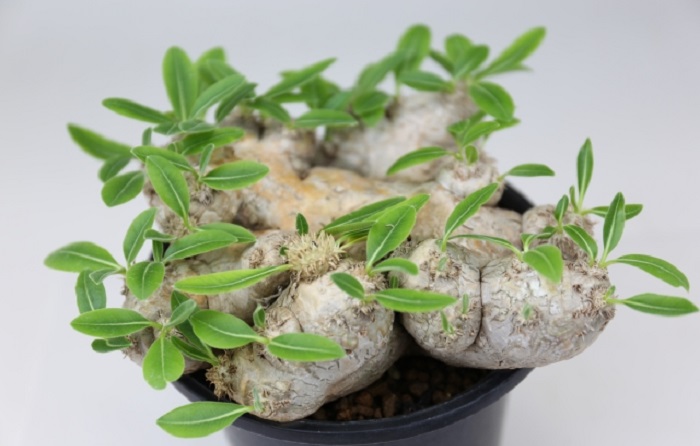 Pachypodium short-stemmed (Pachypodium Brevicaule).
Pachypodium short-stemmed (Pachypodium Brevicaule).
Pachypodium densiflorum is one of the most drought-resistant species. Its thick, fleshy stem, gray-green in color, can reach a height of 90 cm. But it grows very slowly. It differs from other pachypodiums in long thorns similar to the thorns of roses.
Pachypodium succulentum has a turnip-like trunk. The terrestrial part is branched into several strongly shortened processes with bundles of thin small leaves. The flowers that bloom every summer are somewhat reminiscent of small bells, both in shape and color, blue or light purple. In the center of the opened bud is a bright red pharynx.
Pachypodium rosulatum - has a short silvery-green stem. Bottom thickening at the base. Shoots are strictly vertical. Small, narrow leaves are collected by rosettes at the tips of the stems. The color of the flowers is light yellow. Duration of flowering 3-4 months from spring to July.
Pachypodium horombense, looks like an alien creature. The highly branched trunk directs the shoots in the form of an octopus or a multi-pointed star. Decorated with thorns, which are arranged in rows-lines of the correct shape. At the ends of the shoots, neat rosettes of light green narrow leaves are formed. Large yellow flowers form clusters on long stalks.
Care features
Choice of habitat
If possible, it is good to take the plant out to the balcony or garden in the summer. But this can only be done in the absence of night frosts. An ideal place for a representative of exotic flora in the room is the south, southwest or southeast window. In winter, it is quite possible to be near the heater, dry and warm air is easily transferred.
Air humidity and watering
When caring for a pachypodium at home, it is not required to create high air humidity, which makes it easier to grow. In the wild, the plant tolerates both dry and rainy periods.Therefore, you need to know how to water the pachypodium.
Since it accumulates water in its trunk, it must be poured quite discreetly. However, the plant requires more water than most other succulents. The soft fiber inside the barrel absorbs water and acts as a kind of storage tank.
At the same time, stagnant moisture can damage this unusual plant. Root rot appears and the trunk simply collapses. The palm tree does not require spraying, but it can be done in order to wash off the dust.
Interesting. Under natural conditions, the pachypodium tolerates long dry periods well. Although with a regular supply of water, it grows much faster.
Basic requirements for watering:
- wait for the soil to dry after each irrigation;
- use rainwater or well-settled tap water for irrigation.
Advice. It is advisable to plant the Madagascar palm in a clay pot, because, unlike plastic ones, it regulates moisture well.
Temperature and lighting
The favorite habitat of the pachypodium cactus is as warm as possible, with good lighting.
Important! The warmer the habitat of the plant, the more light it must provide. However, areas that are in partial shade are also acceptable.
The pachypodium grows best at temperatures between 20 ° C and 24 ° C, while even tolerating temperatures of 30 degrees Celsius. But it is necessary to ensure that the temperature does not drop below + 18 ° C.
There is no rest, the growing season lasts all year, so in winter you need to try to extend the daylight hours by creating artificial lighting. Otherwise, the trunk expands greatly, the leaves become sparse and pale. In the least favorable conditions, they can partially fall off.
Top dressing and transplanting
To cover the need for nutrients, a single monthly feeding is sufficient, starting in April and ending in September. Fertilizers are introduced 2-3 weeks after the emergence of young shoots. Specialized formulations for cacti are suitable, which are added to irrigation water in a low concentration.
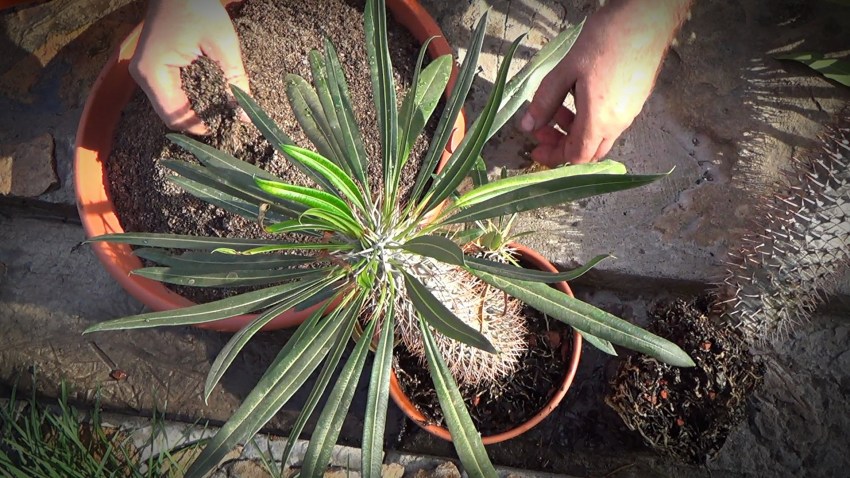
Pachypodium transplant
To optimally care for the pachypodium, a transplant is necessary, which takes into account the following aspects:
- transplant time - spring;
- regularity - every 2 or 3 years, young people - once a year;
- good drainage must be laid out in a new pot;
- it is not recommended to fertilize the plant immediately after transplanting.
Transplanting should be done very carefully, given that the plant has delicate roots. A plant with an earthen lump is neatly placed in a new pot, slightly larger than the previous one, on a layer of drainage and substrate
Then the soil is poured so that at least 2 cm remains to the edge, and it is pressed. Suitable type of soil - special for cacti. If it cooks on its own, then the leafy and sod land is mixed with river sand. Everything is taken in equal shares. After planting, abundant watering is performed.
Important! Not only because of the sharp thorns, but also because of the toxicity of the plant, it is necessary to wear thick gloves when transplanting. The trunk and leaves of the pachypodium contain a toxic milky sap that is harmful not only to humans, but also to animals.
Poisoning symptoms - diarrhea, urinary problems, in severe cases, high fever and breathing problems
The trunk and leaves of the pachypodium contain poisonous milky sap, which is harmful not only to humans, but also to animals. Symptoms of poisoning are diarrhea, urinary problems, fever and breathing problems in severe cases.
For the pachypodium, trimming the apex does not make sense. Only broken or otherwise damaged leaves should be trimmed or removed with a clean cutting tool. This procedure reduces the risk of entry of pathogenic microorganisms.
Due to the irritating and toxic effects of the plant, the cutting tool must be thoroughly cleaned before and after contact with the palm tree.
Variety of pachypodium species
There are a large number of its species, among which there are both dwarf varieties and those that reach 1.5 m in height. No more than 10 varieties are grown in the apartment, which are not distinguished by high growth and have an unusual trunk shape.
Pachypodium lamera - home care
When purchasing a palm tree, it is important to know what the pachypodium loves, what is the care for it at home, the flowering period and the peculiarities of its cultivation in winter, since the growth and development of the plant depends on it
Pachypodium lamerei, or Madagascar palm
When kept at home, the flower reaches no more than half a meter. The plant has a thick, thorny trunk. In young specimens, it is colored dark green, in adult crops, the color changes to grayish-silver. The thickened erect trunk lignifies in the lower part as it grows, tubercles are formed on it, located in a spiral shape.
The Madagascar pachypodium palm has long green leathery leaves that grow only on the top of the plant. Flowers with a golden core are painted in snow-white coffee or light pink, they reach 11 cm in diameter.
The species has 2 varieties:
- typica (the surface of the sheet is covered with nap);
- ramosum (a branched trunk is decorated with leaves with a pronounced center vein, umbrella-shaped snow-white inflorescences reach 10 cm in diameter).
Important! Pachypodium Lamera is unpretentious, home care for it is easy and does not take much time

Lamer
Pachypodium geayi
When grown indoors, it reaches half a meter. The strong trunk is covered with thorns. Foliage with light pubescence - narrow, 10 to 30 mm wide. Young spines are silvery in color, and the tips are black. Snow-white flowers with a lemon core are large, 10-15 cm in diameter.
In nature, the species reaches 6 m in height and 3 m in width.

Zhayi
Pachypodium short-stemmed (Pachypodium brevicaule)
Pachypodium brevicaule is a miniature species with a tuberous flat stem covered with thorns. The plant has no foliage; during ripening, the bush is covered with elongated canary flowers.

Short-stemmed
Pachypodium saundersii
The Sanders pachypodium is an unusual species with an olive-silvery, spherical trunk up to 150 cm high. The surface is covered with few spines 25 mm long. The broad-glossy leaf plate is pointed towards the apex. During flowering, the bush is covered with a large number of snow-white inflorescences with a pink longitudinal stripe along the petal.
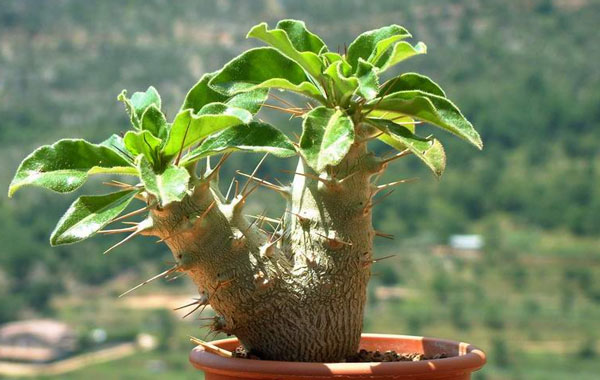
Saunders
Pachypodium succulentum
The species has a turnip root, which, as it grows, turns into a thickened tuber. The root passes into a lignified branched and branched stem. Plant height reaches from 60 to 90 cm. Young shoots are covered with 20 mm paired spines and few glossy lanceolate leaves.
Note! In summer, the bush is covered with bell-shaped flowers of light pink color with a red pharynx. The diameter of the inflorescence is small, about 40 mm

Succulent
Pachypodium rutenbergianum
At home, the species grows to 8 m, when grown in an apartment does not exceed 60 cm in height. Short shoots are covered with thorns 10 mm long. Dark olive glossy foliage with a light central vein has an oblong shape. The leaves are collected in a rosette at the top of the plant. The inflorescences consist of 3-4 large snow-white flowers.
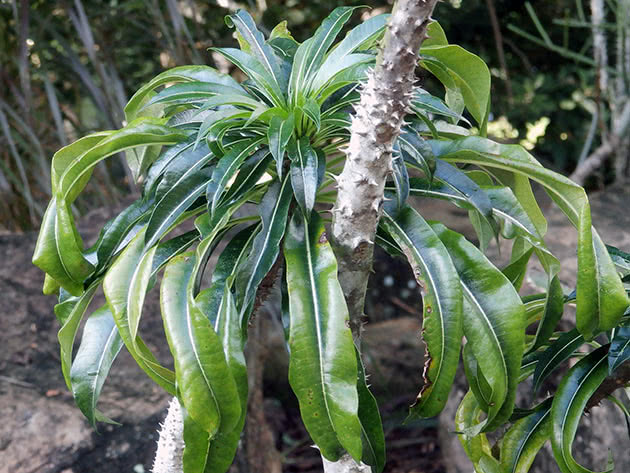
Rutenberg
Views
There are no less than 20 varieties of this amazing succulent. In indoor floriculture you can find:
- The pachypodium lamerei, or Pachypodium lamerei Drake in Latin, is a very popular tree in domestic culture. The powerful, sometimes branching, spiny stem and rosette-forming dark green leaves at the top make the plant a classic member of the genus. The flowers are creamy or pale pink in color with a yellow throat and up to 11 cm in diameter.The spines are located on the tubercles placed in a spiral - 3 pieces on each. In the room, this representative of the flora grows up to 50 cm.
Pachypodium Zhaya, otherwise called Pachypodium geayi, is a tree up to 60 cm in height with a mighty trunk covered with “needles”. Very similar to P. Lamer. It differs from it only in narrower and pubescent leaves. The flowers are white with a yellow throat.
The short-stemmed pachypodium, otherwise called Pachypodium brevicaule, is an unusual variety that, after shedding its leaves, is very similar to a stone. Its flat and smooth stem of a gray shade and up to 60 cm in diameter is completely invisible in nature - so much its color merges with the sand. The yellow inflorescences look very impressive compared to the stem itself.
Pachypodium Lamera branched or otherwise Pachypodium lamerei var. ramosum has a bottle-shaped woody stem and few thorns. Forms thorny shoots. White flowers growing in umbellate inflorescences reach 10 cm in diameter.
Pachypodium Saunders, whose name in Latin sounds like Pachypodium saundersii, is interesting with a spherical stem of gray-green color no more than 1.5 m high, covered with a small number of thorns. The leaves are wide with a tapering base, and the flowers are white, decorated with pink edges.
Pachypodium succulent or otherwise Pachypodium succulentum - a variation with a huge woody stem, like a cobblestone and slightly buried in the ground, small pubescent leaves and pairs of "needles". Bell-shaped buds stand out in pink color and red "sparks" from the center.
Pachypodium densely flowered, called in Latin Pachypodium densiflorum - a variation with rich yellow inflorescences, very slowly growing. Flowering occurs with a stem thickness of about 30 cm in diameter, the maximum height is 45 cm. Small leaves are directed upwards.
Pachypodium horombense Poiss or in Latin Pachypodium horombense Poiss is a low-growing variety with a powerful smooth stem, thin leaves in rosettes at the ends of the shoots and large yellow flowers growing in clusters.
The southern pachypodium, otherwise called Pachypodium meridionale, is interesting for its very large and fragrant pink-red flowers. Over time, it reaches up to 1 m. Its trunk is smooth and silvery brown.
Pachypodium rosette, called Pachypodium rosulatum in Latin, is a form with a short but powerful trunk (caudex), spiny branches growing upward and pale yellow or green-yellow inflorescences.
- a species up to 60 cm high, with a thorny or smooth caudex and elongated thorny branches. Narrow leaves are located in rosettes at the top of the shoots. The inflorescences are colored bright yellow.
Pachypodium Rutenberg, whose name otherwise sounds like Pachypodium rutenbergianum, is a variety with caudex up to 60 cm in diameter, prickly branches, rosettes of glossy leaves of a dark green color. The flowers are large and white.
Breeding methods of the Madagascar palm
It is not difficult to grow your exotic tree almost from scratch; for this you can use seed material or resort to the cuttings method. Each of the methods is effective, the main thing is to follow the basic rules:
Sowing seeds and caring for seedlings
In its natural environment, the pachypodium reproduces exclusively by seeds. To harvest material from a houseplant, secure the ripening, light brown pods with tape or yarn. This ensures that the fruits will not split when the time comes to release their contents.
Before planting, a special soil substrate should be prepared: for 4 parts of coarse washed sand, 1 part of well-rotted organic matter - compost, the same amount of perlite and vermiculite is taken. The mixture should be sterilized before use.
Seeds are sown in the summer, deepening by 5–6 mm, the depth should not exceed 10 mm. The distance between the seeds is 3-4 cm.
Place the container in a warm, dry place.The optimum air temperature is considered, which varies from 27 to 35 degrees. Seeds that have not hatched after 1.5 months are not viable.
Sprouts with 3-4 leaves are ready for transplanting into separate pots, drainage is required.
Rooting stems and cuttings
For reproduction of the pachypodium in similar ways, you can use parts of the stem and root cuttings:
10–12 cm pieces of young, healthy twigs are cut off; it is better to do this in the spring, in May.
The cut sites are washed under running water to remove the secreted milky juice.
Then the segments should be dried in the open air until a crust forms in the place of the cut. You can treat the ends of the cutting with a preparation that stimulates root formation.
For rooting, a substrate with a light, air and waterproof consistency is used; sand is also suitable for this purpose.
It is recommended to moisten the soil from time to time, you can irrigate from a spray bottle
It is important to exclude excess moisture and its stagnation.
Cuttings do not immediately give roots, so the florist needs to be patient. It is possible to grow a new plant from a part of the root, but this method is used very rarely.
Most often, pachypodiums are grown from seeds, but vegetative methods are often the only way to save an ailing, rotten flower.
Reproduction and transplantation
Frequent transplants of the pachypodium are not required. Young trees are transferred every year, and in the same composition of soil mixture in which they grew. More adult specimens do not need it so often - they are not bothered for 2-3 years. Transplant is carried out immediately after wintering or before cold weather. The pot should be at least 1/3 full of expanded clay drainage.

The land is taken ready for cacti or a little sand, crushed charcoal and red brick are added to the usual gardening garden. Their presence will provide drainage, oxygen access to the roots, disinfection, and they will also saturate the earth with essential minerals. In order not to prick on the thorns, the pachypodium is wrapped in a soft cloth and thus moved to a new planter. You can protect yourself from such injury if you blunt the thorns by cutting them a little.
Pachypodium can be propagated by cuttings and seeds.
- Cuttings are separated in the summer, dried on a paper sheet for a week and planted in a mixture of peat and sand. Provide light, warmth and light moisture to the soil.
- The seeds need to be soaked in warm water or a growth stimulator for a day, then spread out on wet sand and lightly sprinkle them. Cover with glass and place in the light at a temperature of + 23-28⁰С. The emergence of sprouts can be expected for a week or a month. Then the glass is removed, and a small pachypodium is grown, not forgetting to moisten the earth.
It is enough to provide this unusual plant with minimal care so that the pachypodium has ideal "forms" - a strong powerful stem and a luxurious rosette of foliage, and also regularly pleases with delicate flowers with a delicate aroma.
Do you like this plant?
Reproduction of the pachypodium
The pachypodium flower is propagated by seeds and cuttings. Both methods are difficult to implement and do not give 100% survival rate. If you know how the pachypodium palm reproduces and make more effort, then you can grow a flowering tree at home.
Seeds
At home, propagating the pachypodium by seeds is quite difficult, but possible. The prepared container is filled with a nutrient substrate. Seeds are sown superficially, sprinkled with a thin layer of earth or sand and spilled with a spray bottle. For quick germination, the container is covered with polyethylene and removed to the warmest place.
After the emergence of shoots, the shelter is removed, the temperature is lowered. After the appearance of 2-3 true leaves, the seedlings dive in separate pots
Choosing this method of reproduction, it is important to remember that a plant grown from seeds grows very slowly.
Important! The pachypodium palm tree, which can be propagated by seeds and cuttings, is difficult to grow at home
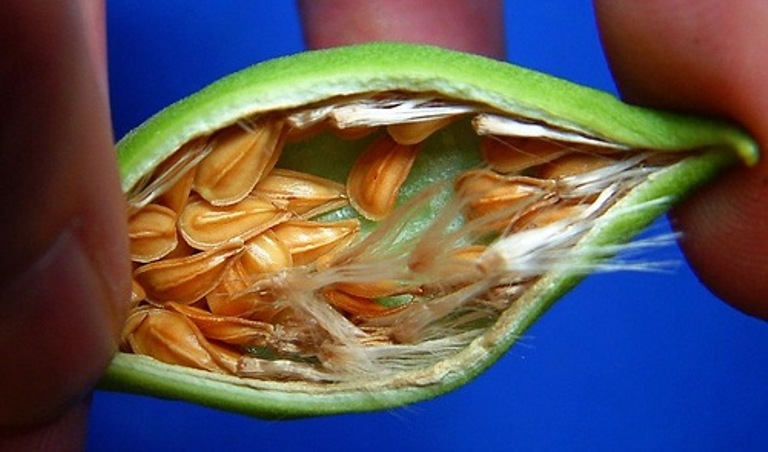
Pachypodium seeds
Cuttings
Pachypodium cuttings root very rarely. However, with an effort, you can still grow a beautiful plant. Cuttings are used if the plant begins to rot from the base. To do this, cut off the top and put it in water until the roots appear. For rapid root formation, a growth stimulant can be added to the water. Also, the trim can be placed in a nutritious soil, covered with a glass jar and removed to a well-lit place. The degree of rooting is determined by the appearance of young shoots.
Home care for the lamer pachypodium
Diseases and pests
We have already said that an exotic cactus can get sick from cold water or a draft, in addition, it is attacked by such parasites:
- Spider mite. You can understand that the plant is suffering from a tick by the yellow border on the leaves. If the pachypodium of the lamer is not treated in time with a special agent, all the leaves will be covered with white spots, and the crown will noticeably thin out. Get a chemical, for example, "Fufan", "Derris". Or simply shower the plant with unscented soap. After processing, try to increase the humidity in the room with a humidifier.
- Thrips. These pests settle on the lower part of the leaf in white colonies, and the upper part of the leaves is covered with spots. These parasites appear due to low humidity and high air temperatures. In this case, treat the plant with Actellic or Decis insecticides. After processing, the room in which the plant will restrain is sprayed with a spray bottle in order to increase the humidity of the air.
Watering the plant
Caring for a plant in an apartment does not require much effort, and the irrigation scheme does not change, it is necessary when the soil dries up. Although many gardeners argue on this topic. Some say that the earth should dry out, others that moisture should always be present. One can argue with the last statement, because the pachypodium lama is thrifty. It "deposits" excess moisture in the trunk, so death from drying is definitely not in danger of it.
For irrigation use water at room temperature, maybe even 2-3 ° C higher. It must be well-kept and clean.
Location
The pachypodium lama is unpretentious, it is quite satisfied with a place in partial shade, but the plant does not tolerate drafts. It dies from the cold blowing air, so pick up a cozy nook. If the plant is overcooled (cold water, air or draft!), Then you will understand this by the blackened leaves that begin to fall off. In the end, the plant just rots away.
In the warm season, move it to a closed balcony, and in a private house, the pachypodium lamera can decorate the veranda. The plant is thermophilic, and fresh air has a beneficial effect on its growth.
Never put a cactus in a nursery or small cramped rooms. It is safe for intact skin, but its sap and needles still contain a strong poison. We recommend that you work with the plant with gloves, and wash your hands thoroughly after watering or transplanting.
Top dressing
An exotic cactus is fed every 2 weeks from the first days of March to the last days of August. Do not use organic, it is better to use mixtures with a low nitrogen content or fertilizer for cacti.
How to plant seeds in the ground?
The seeds must be laid out on top of the soil, and then sprinkled. You can also immerse them flat and again sprinkle them with a thin layer of soil. For sowing a pachypodium lamer, it is better to take a deep container, for example, individual pots, 500 ml plastic cups or a common wooden box. When planting in a common box, make the distance between the seeds more than 10 cm.
Moisten the soil or substrate with a spray bottle, cover the container with seedlings with foil and send it to a warm place. For germination, the ideal temperature is from 24 to 27 ° C, you can illuminate the seedlings with a fluorescent lamp.
Seeds are rarely watered in the greenhouse, it is best to do this once every 2-3 days, when the soil dries well after the previous watering. But you need to air the seedlings daily, removing the film for 1-2 hours.
Description and various types
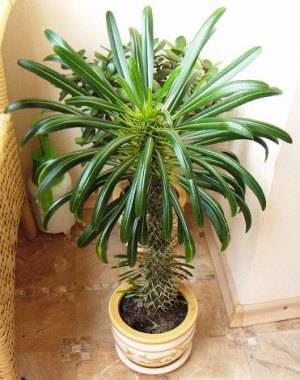 The pachypodium is an amazing plant that combines in its appearance the features of a cactus and a palm tree: a powerful stem and a spreading crown. For this he is called "fat leg" and "Madagascar palm".
The pachypodium is an amazing plant that combines in its appearance the features of a cactus and a palm tree: a powerful stem and a spreading crown. For this he is called "fat leg" and "Madagascar palm".
However, the pachypodium has nothing to do with palms. The Latin name for the plant is Pachypodium. As a member of the shrimp family, the pachypodium is a succulent plant in the arid regions of Africa, Australia and Madagascar.
The fleshy stem of the pachypodium is covered with needles, which makes it similar to cacti, and long leaves, which give the plant a resemblance to a palm tree. During wintering, the long and narrow leaves of the pachypodium most often fall off.
In nature, the pachypodium grows up to 8 meters in height. In indoor floriculture, the plant reaches a maximum of 1.5 meters in height and blooms very beautifully. The growth of the pachypodium is very slow. The life of the plant is from 3 to 15 years, depending on the care.
It is very important to remember that pachypodium sap is extremely poisonous and its spines are very sharp.
Therefore, you need to take care of the plant with caution and with rubber gloves. It also helps to keep the pachypodium away from children and pets.
There are many types of pachypodiums that are successfully grown at home:
- Pachypodium Lamera or Madagascar palm, called Pachypodium lamerei Drake in Latin, is the most popular species with a lush crown and an impressive trunk, decorated with tubercles and powerful spines. The leaves of the plant reach 40 cm in length, and the flowers are painted in a pale cream or pinkish color. Typica subspecies is characterized by pubescence on the back of the leaves.
- Pachypodium lamerei branched (variety), called Pachypodium lamerei var. Ramosum is a variation with wider leaves and large white flowers in umbellate inflorescences.
- Pachypodium saundersii, also called Pachypodium saundersii, is a species with an almost spherical stem and a tuft of broad leaves that blooms with beautiful white flowers with pink stripes.
- Pachypodium geayi or Pachypodium geayi in Latin is a compact species, very similar to Lamer's pachypodium and reaching a height of only 50 or 60 cm.It also differs in narrower leaves and white flowers with a yellow center.
- The densely flowered pachypodium, also called Pachypodium densiflorum, is a species with a lush crown of wide leaves and bright yellow flowers, reaching 45 cm in height.
- The short-stemmed pachypodium, called Pachypodium brevicaule in Latin, is interesting because its short stems are very similar to gray stones up to 60 cm wide, the leaves are small and rounded, and the beautiful yellow flowers are rather large.
- Pachypodium succulent or Pachypodium succulentum - a species with a turnip-shaped trunk, reaching a fairly large size, and wonderful pinkish-red flowers, similar to bells.
- Pachypodium horombense Poiss, called Pachypodium horombense Poiss in Latin, is a species with a large number of chaotically arranged leaves and large yellow flowers.
- The southern pachypodium, called Pachypodium meridionale in Latin, is a species with a long trunk, a small crown of leaves and very unusual pinkish-red flowers, the petals of which curl gracefully and the aroma is beautiful.
- The rosette pachypodium, called Pachypodium rosulatum in Latin, is a species with a powerful caudex (reservoir of water) at the base and branches with bunches of leaves on them, producing flower stalks with beautiful yellow flowers.
- Pachypodium rosette graceful (variety) called Pachypodium rosulatum var. Gracilius is a variation with a more elongated stem, rosette of long leaves and bright yellow flowers.
- The Rutenberg pachypodium, also called Pachypodium rutenbergianum, is a plant that can grow up to 8 meters tall, resembling a palm tree, with glossy leaves, caudex and large white flowers.
Features of growing pachypodium lamer
The pachypodium lamera has a number of preferences and care features, like any other plant. Let's take a closer look at them.
The choice of soil. The flower does not put forward special requirements for the soil.For him, a high-quality soil mixture purchased from a specialized store, and ordinary soil that you brought from your summer cottage, and added a little river sand, are also suitable. But adding a little crushed red brick and charcoal will not only provide good drainage and access to oxygen, but also saturate the earth with the minerals necessary for growth.
In addition, charcoal has excellent disinfecting properties, it perfectly resists the development of infection or decay of the rhizome. But, you only need to use coal from hardwood trees. To do this, simply take a small dry birch branch and burn it.
In winter, the flower is suitable for an air temperature of up to 8 degrees above zero. In fact, there are very few colors that can feel normal at this temperature setting. Usually the minimum requirement for other colors is 16 degrees. But, at this time, it is better to limit watering in order to prevent decay of the root system.
In summer, it is best to stick to a temperature of 25-27 degrees. Watering. This is where flower lovers have the most controversy. Some believe that the pachypodium lamer needs to be watered regularly, slightly irrigating the soil so that moisture is always contained in it.
Others believe that watering the soil in a pot is necessary only when it dries up. In any case, the optimal solution is to moisten the plant when the soil dries out by 1-2 cm. This way you can avoid overflow and the flower will not suffer from a lack of liquid.
In cold weather, watering should be minimized, since moisture does not evaporate so quickly, and the flower does not absorb so many nutrients, being in a period of slow development. At the expense of lighting, you can also not worry. The pachypodium perfectly tolerates both direct sunlight and partial shade, and develops well in both situations.
The humidity of the air around the flower does not play any role. It feels great both in high humidity and near a battery. In addition, you do not need to spray the plant from a spray bottle, except for hygiene purposes. Transfer. The plant does not need constant transplants: a young plant needs to change the pot for more times a year, but an adult pachypodium is better left alone for 2-3 years.
During the transplant, it is imperative to ensure good drainage, fill at least a third of the pot with it, so as not to get stagnant water. Fertilizers. You need to feed the flower every two weeks in autumn and spring, using mineral fertilizers with a low nitrogen content. After transplanting a plant, it does not need to be touched for about a month while it adapts and gets used to new living conditions.
Adhering to these simple rules, you will get a healthy and beautiful flower that looks very original in an ordinary apartment or house.

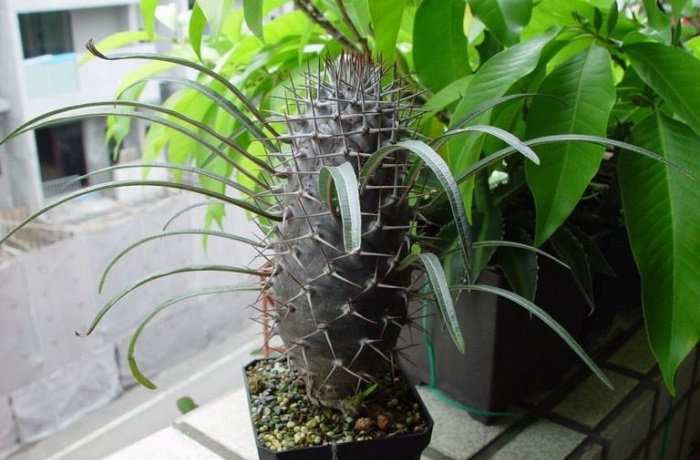 1. Pachypodium geayi - Pachypodium geayi
1. Pachypodium geayi - Pachypodium geayi 2. Madagascar palm or Pachypodium lamerei.
2. Madagascar palm or Pachypodium lamerei.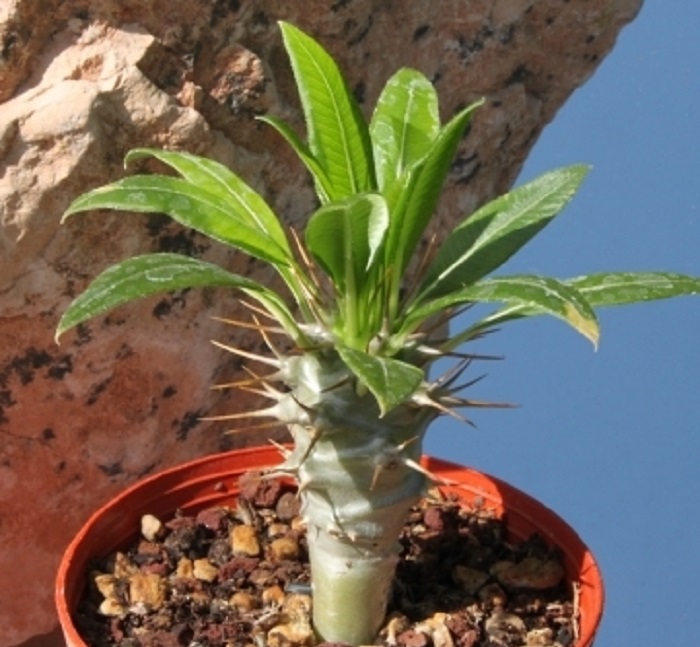 3. Pachypodium lamerei variety Ramosum (Pachypodium lamerei var. Ramosum).
3. Pachypodium lamerei variety Ramosum (Pachypodium lamerei var. Ramosum).

